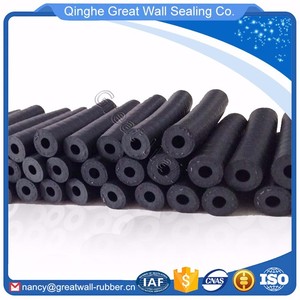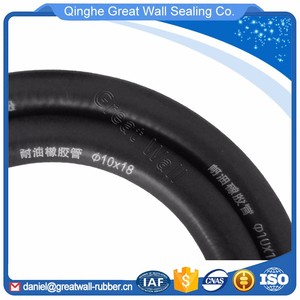(169 products available)
























































































































































































































Air tight flexible hoses are pipes that can bend and are used to connect different parts of a machine. They allow for connections between parts that are not aligned or are at different angles. These hoses are used in different applications, such as air conditioning systems, exhaust systems, and fuel lines. They come in different sizes, materials, and designs depending on the application they are used in.
These hoses are made with materials that can withstand high temperatures and pressures. They are also very durable and can be used in harsh environments. They are called flexible because they can bend easily and are used in applications where rigid pipes would be difficult to install.
There are different types of air tight flexible hoses. They include:
Metal hoses: These are flexible air conditioning hoses made of metal. They are used in applications requiring high strength and durability. Metal hoses are resistant to heat, abrasion, and chemicals. They have a long lifespan and can be used in harsh environments. These hoses are used in exhaust systems, fuel lines, and hydraulic systems.
Rubber hoses: These are made of rubber. They are used in applications where flexibility and lightweight are important. Rubber hoses are easy to bend and install and are commonly used in air conditioning systems and ventilation systems. They can also be used for low-pressure air and water transfer.
Stainless steel flexible hose: These hoses are made of stainless steel. They are known for their durability and resistance to corrosion. Stainless steel hoses can withstand high pressures and temperatures. They are commonly used in applications such as hydraulic systems, fuel systems, and pneumatic systems. They provide a strong and reliable connection between components.
PTFE hoses: These flexible hoses are made of polytetrafluoroethylene. They are used in applications where chemical resistance is important. PTFE hoses are non-stick and easy to clean. They are also resistant to heat and can be used in high-temperature applications.
Silicone hoses: These flexible hoses are made of silicone. They are used in applications where high flexibility and temperature resistance are important. Silicone hoses can withstand extreme temperatures and are commonly used in automotive cooling systems and HVAC systems.
Flexible hose is a crucial component of many systems, and its features and functions include the following:
Lightweight and compact
Flexible hoses are lightweight and compact, making them easy to handle and transport. Their flexibility also allows them to be adjusted and fitted into different configurations and spaces, making them convenient in various applications.
Corrosion and weather resistant
Flexible hoses are usually manufactured from materials that are resistant to corrosion and weather. This increases their lifespan and ensures they continue to function optimally in different environments and conditions.
Pressure resistance
A tight flexible hose is designed to withstand high pressures. It ensures the system it is connected to is safe and provides a reliable source of fluid or air transmission.
Compatibility with various media
These flexible hoses can be used with different types of media, including hydraulic fluids, air, gas, and water. This makes them versatile and suitable for use in various industries and applications.
Ease of installation and maintenance
Flexible hoses are easy to install and require minimal maintenance. This makes them a cost-effective solution for fluid or air transmission. Their flexibility also allows them to fit into tight spaces, making them convenient in various applications.
Leak prevention
These hoses are designed to create a tight seal, preventing leaks. This ensures the efficient transmission of fluids and gases and minimizes the risk of accidents or hazards. Some hoses also have leak detection systems that ensure any leaks are detected and reported.
Versatility
Flexible hoses can be used in various applications, including drainage, ventilation, electrical wiring, and fluid transfer. Their versatility makes them a preferred choice in many industries.
Enhanced aesthetics
Air tight flexible hoses come in different shapes and sizes that enhance the aesthetics of a product or system. Their sleek and modern appearance makes them a better choice for applications where aesthetics are important.
Air tight flexible hoses have diverse applications across different industries and sectors. Here are some common usage scenarios:
Plumbing Systems
Flexible plumbing: Airtight flexible hoses are used in plumbing systems to create leak-proof connections between pipes. They accommodate slight misalignments or movements in the system. Water supply: They are used in water supply lines to connect faucets, toilets, and showers to the main water source. Their flexibility and airtight nature ensure efficient water delivery and reduce leaks.
HVAC Systems
Air Ducts: These hoses are employed in heating, ventilation, and air conditioning (HVAC) systems. They facilitate the transfer of air from ducts to vents. Their flexibility allows for complex routing while maintaining airtightness, ensuring efficient airflow and minimizing energy loss. Refrigerant Lines: Airtight flexible hoses are used to connect components in HVAC systems, such as compressors, condensers, and evaporators. Their flexibility accommodates vibrations and movements while maintaining airtight refrigerant circulation.
Automotive Applications
Emissions Control: Flexible hoses are used in automotive applications. For example, they connect exhaust components like catalytic converters and mufflers. Their flexibility allows for smooth exhaust flow while minimizing vibrations and stresses on the system. Brake Systems: Flexible brake lines are employed in vehicles' braking systems. They connect the brake pedal to the brake calipers. Their flexibility accommodates wheel movement while providing a firm and airtight connection for hydraulic brake fluid transfer.
Industrial Applications
Fluid and Gas Transfer: Airtight flexible hoses are commonly used in industrial settings. For instance, they transfer fluids (such as oil, water, and chemicals) or gases (such as air and nitrogen) in a variety of industries. Their flexibility allows for complex routing and connections between stationary and moving parts. This ensures minimal leakage, which enhances efficiency and prevents environmental hazards.
Consumer Appliances
Kitchen Appliances: These hoses are widely used in household appliances. For instance, they connect refrigerators to water sources for ice makers and water dispensers. Their flexibility and airtight nature ensure leak-proof connections and convenient kitchen operations. Washing Machines: Airtight flexible hoses are used to connect washing machines to water supply and drainage lines. Their flexibility allows for efficient water intake and discharge during the washing cycle, enhancing the machine's performance.
Medical Equipment
These hoses are used in various medical devices and equipment. For example, they connect oxygen tanks to masks or nasal cannulas in respiratory systems. Their flexibility allows for patient movement while ensuring airtight oxygen delivery. Additionally, these hoses are used in intravenous (IV) fluid administration. Their flexibility accommodates the patient's position while ensuring a steady and airtight flow of fluids.
When choosing the ideal air tight flexible hose for a project, it is important to consider various factors. This ensures that the hose is suitable for the intended application. Below are some of the important factors to consider:
Material:
The first thing that should be considered is the material used to manufacture the hose. Air hoses are made from different materials, and each material has its advantages and disadvantages. Some of the materials used to manufacture air hoses include rubber, PVC, nylon, and polyurethane. Rubber is flexible and highly durable, while PVC is lightweight and affordable. Consider the environment in which the hose will be used. For example, if the hose will be exposed to extreme temperatures, UV light, or chemicals, choose a material that can withstand those conditions.
Diameter and Length:
The diameter and length of the hose will affect its performance. A long hose with a small diameter will reduce airflow, while a short hose with a small diameter will increase airflow. It is important to choose a hose with the right diameter and length to ensure the system works optimally.
Pressure Rating:
All air tight flexible hoses have pressure ratings. This indicates the maximum pressure at which the hose can safely operate. When choosing a hose, ensure that the pressure rating is higher than the intended pressure to avoid accidents.
Temperature Resistance:
Some applications work in extremely high or low temperatures. Therefore, it is important to choose a hose that can comfortably operate within those temperature ranges. This prevents the hose from becoming damaged or failing completely.
Compatibility:
The air tight flexible hose is used to transport different materials. It is important to ensure the hose is compatible with the material it will be transporting. For example, if the hose is used to transport chemicals, choose a material that is resistant to chemical corrosion.
Hose Construction:
The construction of the hose will affect its flexibility, weight, and durability. Hoses made from single layers are lighter and more flexible. On the other hand, those made from multiple layers are more durable and resistant to external factors like abrasions and UV light.
Q1: What are the quality standards for an air-tight flexible hose?
A1: The ISO 10365: 1992, which is the international standard for flexible hoses, applies to an air-tight flexible hose for conveying fluids. The standard shows the classification, specifications, and tests that should be carried out on the hose before it is certified fit for use.
Q2: What are the key features of an air-tight flexible hose?
A2: Key features include an airtight connection, durability, flexibility, corrosion resistance, and various sizes and lengths.
Q3: What is the minimum order quantity for an air-tight flexible hose?
A3: The minimum order quantity varies among suppliers on Chovm.com. Some have a MOQ of 50 pieces, while others have a MOQ of 1000 pieces. Interested buyers can check the MOQ of a supplier before placing an order.
Q4: Can an air-tight hose be used for hot water?
A4: An air tight flexible hose can be used for hot water only if it is made from metal or a material that can withstand high temperatures. However, hoses made from plastic or similar materials may not be ideal for hot water.